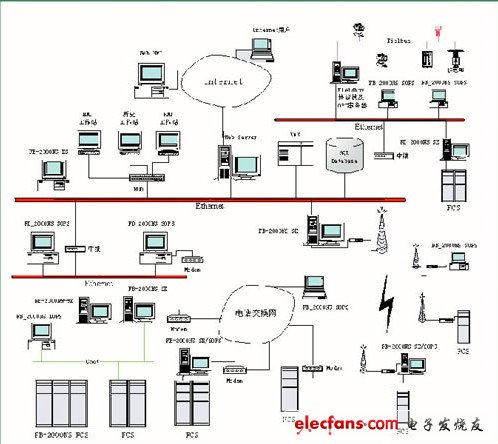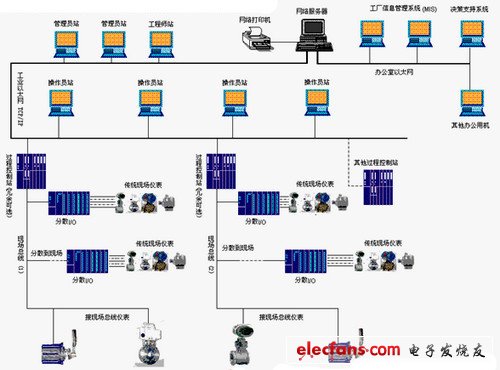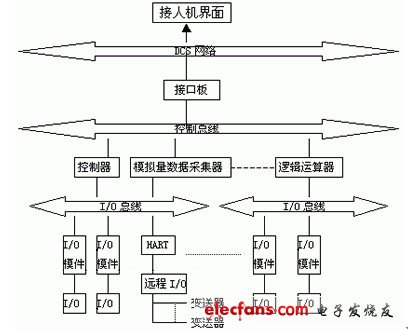What does DCS mean?
DCS is a highly integrated product of computer technology, control technology and network technology. It is currently the most advanced and reasonable process control system and can adapt to various process control requirements. Its process control points are scattered, and the system has high reliability. Through centralized operation and monitoring, DCS has convenient operation and maintenance performance. DCS has a standard interface, which is more convenient and simple for external connection. The main feature of DCS comes down to one sentence: "decentralized control, centralized management". 
DCS is a system control system, also known as distributed control system. This kind of system is produced with the rise of large-scale industry, which solves the problem that the entire system cannot run safely due to a small system in the control of some industries with complex systems, harsh environments, and cumbersome process flows. There are mainly two kinds of PLC and DCS, DCS can complete more complex logic operations, especially for the collection and processing of some analog signals such as temperature, pressure, flow, etc., all are automated and modularized, which is very simple and practical.
DCS (DistributedControlSystem) is an abbreviation of a multi-level computer system composed of a process control level and a process monitoring level, with a communication network as the link. ) And other 4C technologies, the basic idea is decentralized control, centralized operation, hierarchical management, flexible configuration, and convenient configuration.
The structure of DCS control system
The process control station of DCS is a complete computer system, mainly composed of power supply, high-performance central processing unit (CPU) and network interface. The high-performance central processor is the center of on-site process control, storing and running all process control programs as well as on-site instrument data and control data. DCS's control decisions are all executed by it. The network interface of the process control station is the connection channel to the operator station and the engineer station at the same level. The operation control information of the operator and the configuration program of the engineering station are sent to the process control station through this channel, and the field data collected by the process control station is also transferred to the operator station through this channel. The process control station and I / O modules are connected via a field bus. A PC for operation, monitoring, alarming, trend display, recording and printing reports. The operator station is usually equipped with operating software to complete the above functions, and is connected to the process control station via Ethernet. A computer used to configure process control software, diagnose and monitor the operation of process control stations, and be used by DCS engineers to develop, test, and maintain DCS systems.
DCS usually uses several controllers (process stations) to control many control points in a production process, and each controller is connected through a network and can exchange data. The production control operation uses a computer operation station, which is connected to the controller through the network, collects production data, and conveys operation instructions. Divided structurally, DCS includes process level, operation level and management level. The process level is mainly composed of process control stations, I / O units and field instruments, and is the main implementation part of the system control function. The operation level includes: operator station and engineer station to complete the operation and configuration of the system. The management level mainly refers to the factory management information system (MIS system). As a higher-level application of DCS, there are currently fewer systems applied to this layer in the domestic paper industry. 
DCS usually uses several controllers (process stations) to control many control points in a production process, and each controller is connected through a network and can exchange data. The production control operation uses a computer operation station, which is connected to the controller through the network, collects production data, and conveys operation instructions.
Divided structurally, DCS includes process level, operation level and management level. The process level is mainly composed of process control stations, I / O units and field instruments, and is the main implementation part of the system control function. 
The operation level includes: operator station and engineer station to complete the operation and configuration of the system. The management level mainly refers to the factory management information system (MIS system). As a higher-level application of DCS, there are currently fewer systems applied to this layer in the domestic paper industry.
Development of DCS control system
DCS will expand to information management system and computer network control, and closely integrate process control and information management system to form computer integrated process system (CIPS). In addition to the functions of traditional DCS process control, CIPS also needs to implement the functions of operation support and decision support, including quality control, process management, online optimization, operation management, and decision analysis. The network is the core of today's factory automation and the basis of computer integrated process systems, and every layer of factory automation has its own network.
The factory level (upper layer, management level) includes factory information management and production management, and is responsible for the connection with the factory management computer. The management data exchange between computers is realized through the factory backbone network. The backbone network adopts ISO / OSI-MAP / TOP or TCP / IP-Ethernet network protocol standards. As the scale of factory automation continues to expand, this level of function is getting stronger and stronger, it is an important sign of the development of DCS to CIPS.
The workshop level (middle level, monitoring level) includes process control and process management, used for the connection between the control room, field control equipment and various field control devices. The communication network adopts the form of medium speed, carrying industrial process data highway (ProwayC or IEEE802.4). This is a real-time industrial control network of DCS, which should have high reliability, high usability, strong real-time performance, self-diagnosis function, self-configuration function, and easy access to new stations.
The field level (lower level) is used to connect sensors, actuators, and intelligent instruments in process control. The field takes the standard field bus as the development goal. There are now field bus products from two international organizations. The field bus will be an important direction for the development of DCS.
DCS communication network
1. Development History With the continuous development of computer technology, network technology and control technology, DCS has experienced four development periods since its advent in the 1970s, specifically divided into:
(1) The initial period from 1975 to 1980. At this time, the DCS communication system is just a primary local network, and the whole system is commanded by a communication commander, and the access to each unit is an inquiring way in turn. Such as TDC-2000, MOD-3, etc.
(2) 1980-1985 mature period. Using a local area network, the master-slave star network is transformed into a peer-to-peer bus network communication or ring network communication, which expands the communication range and improves the transmission rate. Such as TDC-3000, MOD-300, etc.
(3) 1985-1990 expansion period. In the local area network, the international standard organization ISO's OSI open system interconnection reference model is adopted, so that the products of various manufacturers that comply with the open system can be interconnected, communicated with each other, and exchange data, and third-party software can be applied. It has changed the closed structure of DCS's self-contained system in the past. DCS has been developed from the original only application to not only application but also development. TDC-3000 (with UCN network) Centum XL, etc.
(4) After the 1990s, the network opened. Use communication protocols and procedures that comply with international standards, namely IEE802 (Ethernet), IEE802.4 (Token Bus), EEFDDI (Fiber Optic Distributed Data Interface), TCP / IP (Transmission Control Protocol / Interconnection Protocol), or MAP (Manufacturing Automation Agreement), etc., so that computers of different manufacturers and different operating systems can coexist with a network standard to achieve the purpose of product exchange and resource sharing. Such as Centum CS-3000, Advant-500, etc.
2. The characteristics of the communication network The communication network is an important pillar of the DCS. The units that perform decentralized control and the human-machine interfaces at all levels must be integrated into one by the communication system. The communication network is called a local area network (LAN). It is a local network with high communication rate, low bit error rate, and fast response. It has the characteristics of flexible organization, easy expansion, and resource sharing. However, DCS completes industrial control, so it is different from the general office local network. , With the following characteristics:
(1) With fast real-time response capability, the general office automation computer local network response time is 2-6s, and it requires 0.01-0.5s
(2) It has extremely high reliability and must be operated continuously and accurately. The data transmission error rate is lower than 10-8-10-11, and the system utilization rate is above 99.999%
(3) It is suitable for working in harsh environments and can resist power supply interference, lightning strike interference, electromagnetic interference and low potential difference interference.
(4) Hierarchical structure. In order to adapt to the hierarchical structure of DCS, its communication network must also have a hierarchical structure, such as field bus, workshop-level network system, and factory-level network system.
3. The hierarchical system of the communication network The communication networks of the early DCS systems are all dedicated. The DCS has several levels of networks to complete the communication between different modules. From the current situation, the maximum network level of DCS has four levels, which are I / O bus, field bus, control bus and DCS network. 
(1) I / O bus It sends various I / O signals to the controller, and the controller reads the I / O signals. The I / O modules do not exchange data. The I / O bus includes a parallel bus and a serial bus. The transmission rate of the I / O bus is not high, ranging from tens of K to several megabytes. For fast, it is best to use a parallel bus. With a parallel bus, its I / O module must be adjacent to the controller module. If a serial bus is used, the distance between the I / O module and the controller must be relatively short. Controller modules and I / O modules are usually installed in one cabinet or adjacent cabinets.
(2) Fieldbus Fieldbus was developed in the early 1990s, and remote I / O should use fieldbus, such as CAN, LONWORKS, HART bus, etc. In the DCS system, the remote I / O uses HART bus more. For example, the on-site transmitter is far away from the controller cabinet. The signals from 16 transmitters are often grouped into a group, and the signals are sent to the controller using the HART bus. The controller reads in 16 transmitters at the same time. signal of. Using fieldbus, the distance between the controller and the transmitter can be more than 1 km.
(3) Control bus The three controllers that complete different tasks are connected to a bus to realize the communication between the controllers, called the control bus. The number of different controllers on the control bus is not limited. In addition to three different controller modules on this bus, there are interface modules for the DCS network. On the control bus, data can be transferred between the controllers, making the combination of analog and switching quantities very good. The control bus is not available in the DCS system, and various controllers can be connected to the DCS network respectively, and the data transfer between the controllers is through the DCS network. The transfer rate of the control bus is similar to the transfer rate of the I / O bus. It is usually between tens of K and megabytes. When the capabilities of the CPU and the memory are relatively strong, the logic operation of the switching value and the acquisition function of the analog quantity are all completed in one controller, so that there is only one form of controller on the control bus. The communication protocol is similar to Ethernet, using carrier monitoring and token broadcast transmission.
(4) DCS network It connects the field controller and the man-machine interface into a system. In order to ensure reliable communication, DCS manufacturers make redundant cables, whether they are cables or communication interfaces. One network fails and the other standby network is immediately put into operation. The components connected to the DCS communication network are called nodes (nodes). In terms of geographic location, the nodes can be distributed, and the distance of each node is different for each DCS system, and some can reach hundreds of meters. The transmission rate of the DCS network is between several hundred K and one hundred megabytes, the total length of the network can reach several kilometers, and the shortest is several hundred meters. When the network is not long enough, a repeater needs to be added.
The development of computer integration technology and field bus will have a significant impact on the structure of DCS. At present, the structure of DCS will be dismembered from above and below. The upper-level workstation will be closely integrated with CIPS. DCS will evolve into the lower part of CIPS. At the field level, the application of fieldbus will completely change the traditional DCS I / O structure. The field bus will have a profound impact on the field of automatic control. The architecture of the industrial control system will consist of a unified field bus. The field control system (FCS) will be an open control system in the 21st century.
The Transient Voltage Suppressor (TVS) is a high-performance protection device in the form of a diode. When the two poles of a Tvs Diode are subjected to a reverse transient high-energy shock, it can change the high impedance between the two poles to a low impedance at a speed of the order of 10 minus 12 powers, absorbing up to several kilowatts of surge power. The voltage between the two poles is clamped to a predetermined value, effectively protecting the precision components in the electronic circuit from various surge pulses.
Transient Voltage Suppressor
Transient Voltage Suppressor,Tvs Diode,Tvs Diode Ethernet,Tvs Diode For Automotive
Dongguan Agertech Technology Co., Ltd. , https://www.agertechcomponents.com